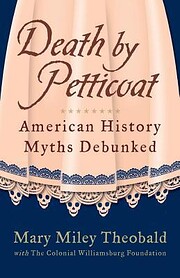

Pulse en una miniatura para ir a Google Books.
|
Cargando... Death by Petticoat: American History Myths Debunkedpor Mary Miley Theobald
 Books Read in 2014 (1,246) Summer Reads 2014 (204) Actualmente no hay Conversaciones sobre este libro.   ) )This little book covers a collection of popular, oft-repeated myths of American history, both the completely fabricated and those with a grain of truth vastly over-inflated to make a better story. The title refers to the claim that long skirts and petticoats were so likely to catch fire that "death by petticoat fire" was the second leading cause of death for colonial American women, with only childbirth beating it out. In fact the leading cause of death for colonial American women was disease--and the cottons, wools, and linens that made up colonial era clothing were a lot less flammable than the polyesters, rayons, and nylons commonly found in modern clothing. Overall, this is a brisk and sensible book with a sense of humor and an understanding of how and why "myths" catch on and are hard to dislodge. This includes the discussion of the myth of houses being burned down to collect the "valuable" nails used to build them. In fact, nails weren't all that valuable, and no one burned down substantial houses just to get the nails. The first settlers at Jamestown, though, were mostly unattached young men who came to make a quick fortune and go home. They didn't build substantial homes; they built shacks. When they realized they'd be staying, these shacks were easier to burn down than tear down--and once burned down, why not collect the nails? They weren't especially valuable, but they weren't worthless, and why waste them? In some cases, though, there seems to be a failure to think things through. In the discussion of ice cream, Theobald concludes, for reasons she doesn't really explain, that the Chinese "probably" invented ice cream. The problem with this is that the Chinese don't consume dairy products. Most Chinese, like most adults in areas that have been civilized for a long time, don't produce the enzyme necessary to digest dairy products. It's not likely they invented ice cream. Europeans and their descendants in the Americas are not the only possible candidates, but would have to be serious contenders. It's a small point, but it does cause me to wonder a bit about some of her myth explanations that I don't know enough about to make my own judgment. Still, it's an interesting and entertaining read, as well as a quick one. This could be a fun title to bring along when taking the children to visit historical American sites. I received a free electronic galley of this book from the publisher via NetGalley. A brief pamphlet-like book debunking American history myths. Since I had never heard the bulk of these "myths" it's hard to say how good this book is. I confess to wishing for some citations, although I admit it's difficult to find a citation for "there are no citations for this idea, who knows where it came from." An interesting little book that debunks myths about the colonial era. Some I had heard of and others were new to me. I wish the author had included a few real facts that are sometimes thought of as myths. I also wish that the book had a little more meat to it, as it was almost too brief. I would have enjoyed it a lot more if she had elaborated on each myth. sin reseñas | añadir una reseña
Every day stories from American history that are not true are repeated in museums and classrooms across the country. Some are outright fabrications; others contain a kernel of truth that has been embellished over the years. Collaborating with The Colonial Williamsburg Foundation, Mary Miley Theobald has uncovered the truth behind many widely repeated myth-understandings in our history in Death by Petticoat including: * Hat makers really were driven mad. They were poisoned by the mercury used in making hats from furs. Their symptoms included hallucinations, tremors, and twitching, which looked like insanity to people of the 17th and 18th centuries--and the phrase "mad as a hatter" came about. * The idea that portrait painters gave discounts if their subjects posed with one hand inside the vest (so they didn't have to paint fingers and leading to the saying that something "costs an arm and a leg") is strictly myth. It isn't likely that Napoleon, King George III, or George Washington were concerned about getting a discount from their portrait painters. Pregnant women secluded themselves indoors, uneven stairs were made to trip up burglars, people bathed once a year, women had tiny waists, apprenticeships lasted seven years--Death by Petticoat reveals the truth about these hysterical historical myth-understandings. No se han encontrado descripciones de biblioteca. |
Debates activosNingunoCubiertas populares
 Google Books — Cargando... Google Books — Cargando...GénerosSistema Decimal Melvil (DDC)973History and Geography North America United StatesClasificación de la Biblioteca del CongresoValoraciónPromedio: (3.41) (3.41)
¿Eres tú?Conviértete en un Autor de LibraryThing. |
||||||||||||||||||||||||||||||||||||||||||||||||||||||||||||||||||||||||||||||||||||||||||||||||||||||||||||||||||||||||